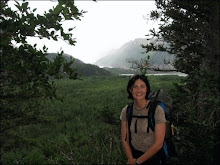
Scott and I had Sea Ice Training today! This is a one day course that teaches us important things like: how to avoid driving over cracks in the ice that are too big for your vehicle, how to anchor a tent to bare ice, how to avoid falling into holes in the ice, how to help someone who has fallen into the ice, etc. We did a small amount of classroom prep, then hopped into the Hagglund to drive over the sea ice to an area that had some cracks in it.

The coast immediately around McMurdo station has remained frozen since around 2000, so we had to drive a way out before we could find ice thin enough to have developed good, measure able cracks. This afforded us some amazing scenery. Also, driving over the ocean is a Hagglund is awesome!

The ice was covered in over a foot of new snow from the blizzard, so our instructor pointed out areas where he had previously GPS marked cracks. Before we could measure the cracks, we had to dig away all the snow. As a general rule, if the ice is less and 30 inches thick in the crack, you can only drive over it if the width of the crack is less and 1/3 the length of your vehicles contact point. For example our hagglund covers 6 feet of ground as it drives, so we could cross a two foot crack, even if it went all the way to the water.

to measure thickness, you drill holes into the deepest part of the crack, and the edges of the crack. You have to keep adding lengths of drill, because the ice is often several meters thick.

Once you hit seawater, you stick a measuring tape with a heavy metal bar tied to it into the hole. When you pull the tape, the bar gets pulled sideways and hits on the bottom of the ice. You can then find out whether or not the ice in the crack is thin enough to worry about measuring the width of the crack.

Although this is all useful information, we do not have vehicles at Cape Crozier. Our main concern will be not stepping into a crack and getting hypothermia. This was covered briefly in the course a well, as we wandered around in the pressure ridges, looking for danger. And seals. Soon to come: Pressure Ridges and Weddell seal photos!!!!

No comments:
Post a Comment